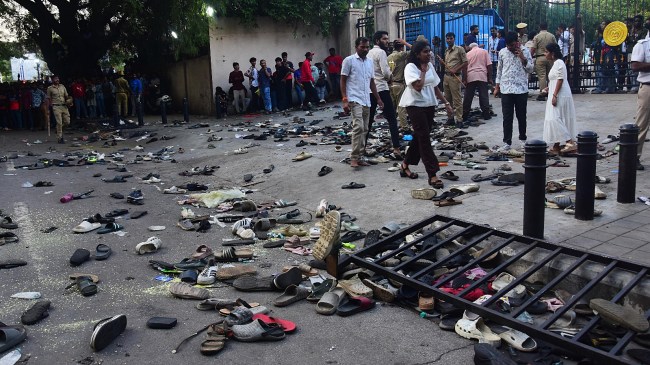Opinion From the Opinions Editor: Stampedes, like those in Bengaluru last week, can be prevented
Crowds will be a par for the course in India. Ensuring their safety requires scrupulous attention to detail – technology can help, so can human psychology
 Scenes outside the M Chinnaswamy stadium after the stampede took place on June 4. (Express file photo)
Scenes outside the M Chinnaswamy stadium after the stampede took place on June 4. (Express file photo) An occasion that was meant to be a celebration turned into a tragedy last week. Eleven Royal Challengers Bengaluru (RCB) fans had to part with their lives and more than 40 others suffered injuries in a stampede that occurred primarily because event management in India hasn’t found a way to come to terms with the crowd. Crowds are par for the course in India. And, in a country of monumental diversities, the chances of their being unpredictable shouldn’t also be ruled out. Yet, an analysis of stampedes in recent times, whether at Hathras last year or during the Kumbh or last week’s tragedy in Bengaluru, points to familiar lapses — poor planning, faulty communication, insufficient understanding of the crowd’s emotion and failure to take damage control measures.
Crowd management is an evolving discipline and there cannot be a fixed template for controlling congested gatherings — pilgrims tend to behave differently from people waiting for a train at a railway station or a politician’s followers. However, global experience has made some fundamentals clear. The first thing to do is to keep crowd densities to manageable levels — less than four persons per square meter is the ideal That’s the task primarily of the local administrative and police authorities along with the event organisers. The National Disaster Management Authority’s guidelines prescribe coordination among these authorities. However, crowds are frequently known to exceed the estimated numbers — whether at a religious congregation, a political rally or a celebration like that organised for the RCB last week. Given that cricket is almost a religion in large parts of the country, the organisers should have anticipated that the crowd for the RCB felicitation event would swell beyond the capacity of the Chinnaswamy stadium — at 35,000, it’s not amongst the biggest in the country. The mood in the city after RCB’s victory could have given the authorities some cues about the scale of people who would throng Bengaluru’s streets to cheer their heroes on the fateful day. But by their own admission, they failed to anticipate the numbers.
The next step, then, would have been to look out for any sign of anxiety. Crowd management studies say that the individual member of a large gathering in a congested area has a very limited ability to perceive what’s going on. And in any case, they don’t have any capacity to control its behaviour. This creates a situation rife for panic. Experts say that crowds must be broken into smaller groups, and authorities must try to prevent a congregation from turning into a single mass. That did not happen at the RCB felicitation event. It has joined a list of tragedies in which the first to get ruffled were those who should have been exercising a calming influence.
Public awareness is another basic precept. The Tirupati Balaji temple, for instance, conducts regular awareness sessions for devotees. The Hillsborough stadium disaster in the UK 1989 led to the evolution of crowd management protocols for sports events. Such preparations may not be possible in a spontaneous gathering such as the one after RCB’s IPL victory. Clear communication becomes more important in such situations. However, in Bengaluru last week, misleading public address advisories added to the confusion. A first aid-providing system should have been kept on high alert. But there was scarcely anyone to lend a helping hand when people started stumbling and tripping in their rush towards the stadium.
Crowd management demands attention to the minutest detail. That’s not as difficult a task today compared to even five years ago. Technology can help keep an eagle’s eye at most congested events. CCTV cameras are common law and order aids in most Indian cities. AI and drones enable real-time monitoring and improve coordination among administrators, event managers, and participants. In many cases, keeping a tab on social media can help gauge sentiments.
 Footwears lie on the ground outside the Chinnaswamy Stadium following a stampede. (Photo: PTI)
Footwears lie on the ground outside the Chinnaswamy Stadium following a stampede. (Photo: PTI)
Stampedes can be prevented. Ensuring safety at large gatherings requires scrupulous attention to every detail. Turn to technology and take lessons from human psychology. No lives should be lost in a crowded event. That would be the best tribute to those who lost their lives in Bengaluru last week.




